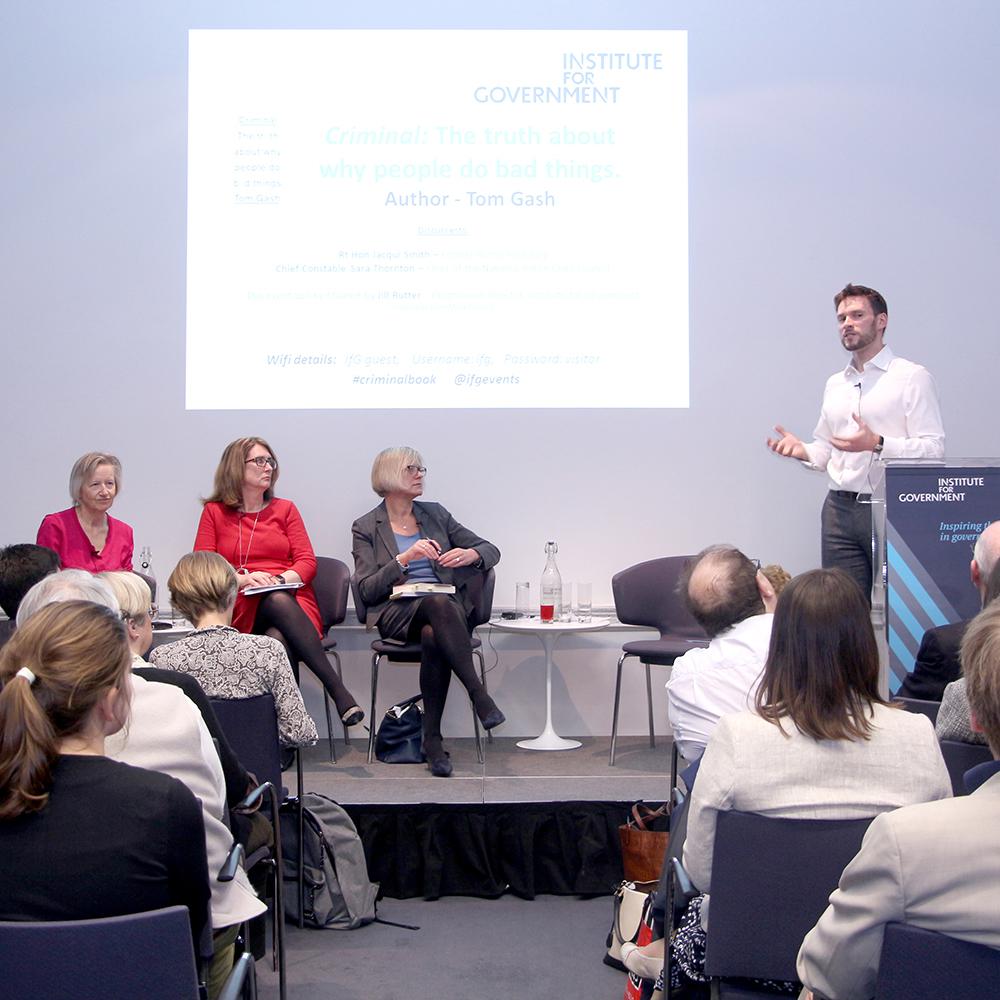Tom Gash’s new book, Criminal: The truth about why people do bad things, explores eleven myths around crime and criminality. At a launch event at the Institute for Government on 27 April, he discussed what this means for criminal justice policy with former Home Secretary Jacqui Smith and Sara Thornton CBE, Chair of the National Police Chiefs Council.
A mass redeployment of policing resources to Oxford or Midsomer – two murder hotspots, if you believe what you watch on TV – would strike most people as absurd. But, as IfG Senior Fellow Tom Gash argues, many pet criminal justice policies are based on less obvious but also highly misleading assumptions.
Sensible crime policy becomes collateral damage in a battle between two simplistic narratives: Heroes and Villains on the Right, with good guys (police) battling highly organised and committed bad guys (criminals); or the Left’s Victims and Survivors, where crime is an almost inevitable consequence of poverty and inequality.
Introducing his book, Tom focussed on the simple fact that while crime is seen as a big issue requiring big solutions, there were many small interventions that could make a big difference. He singled out two – the dramatic fall in motorcycle theft in Germany in the early 1980s and the halving in alcohol-related crime in Surfers’ Paradise on Australia’s Gold Coast. The answers are in Criminal – but, mild spoiler alert, neither depended on the usual levers we try to use to reduce crime.
Instead, change resulted from reshaping opportunistic “in the moment” decisions. Reducing opportunities to make bad (criminal) decisions can dramatically reduce the incidence of some crimes.
But the fact that these interventions worked challenges our notions of either determined hardened criminals, or crime as a direct consequence of poverty. They depended on grappling with detail and data; they also had the big advantage of being very cost-effective.
Both former Home Secretary Jacqui Smith and former Chief Constable Sara Thornton supported Tom’s conclusion ─ that there are many useful insights for policymakers and practitioners to be gained by getting behind the headlines. Jacqui Smith recalled being taken to a meeting with mobile phone companies by her officials to discuss designing out crime from mobile payment, and thought an opportunity had been missed on cybercrime, which was set to show a massive rise when new crime statistics came out later in the year. Sara Thornton thought policing had become more evidence-based – for example on “hotspot” policing, and there was now more genuine policy co-production with the Home Office.
Tom cautioned against knee-jerk responses that led to big gestures with potentially few results. Jacqui Smith warned that few politicians, with their desire to make their mark in the short-term and a tendency to reach for legislation, went into politics to do small things. But she felt the signalling role of legislation was important, and that gestures could provide cover for significant lower-key changes.
It was less clear that Sara Thornton shared the view that gestures were so benign. Both Jacqui Smith and Sara Thornton cautioned about the problem of getting too far away from what the public thought they wanted. Most of the public wanted the reassurance of “bobbies on the beat”. The task for those in authority was to deploy effectively – which could mean taking on those in, and representing, low-crime neighbourhoods that were comparatively over-policed. Jacqui Smith admitted she found that an easier approach to promote now she was no longer in frontline politics!
Both also agreed that neighbourhood policing itself was a vital source of intelligence for local decision-makers. Intriguingly, Jacqui Smith believed she could be more effective at making cross-agency work happen as a health trust chair than as Home Secretary.
So where does that leave the debate about effective crime policy? Three conclusions from our discussion.
First, a recognition of the importance of non-standard criminal justice interventions – from changing the role of bouncers to providing better personal relationship education in schools.
Second, better data (and better use of data) can offer new insights on what might work – and there need to be good ways of testing and sharing findings.
Third, this is an area which would benefit from real clarity about what governments really hope to achieve through criminal justice – and a greater willingness to take on some of the “myths” on which policy is often based. Tom’s book is a great place to start that debate.
- Topic
- Policy making

